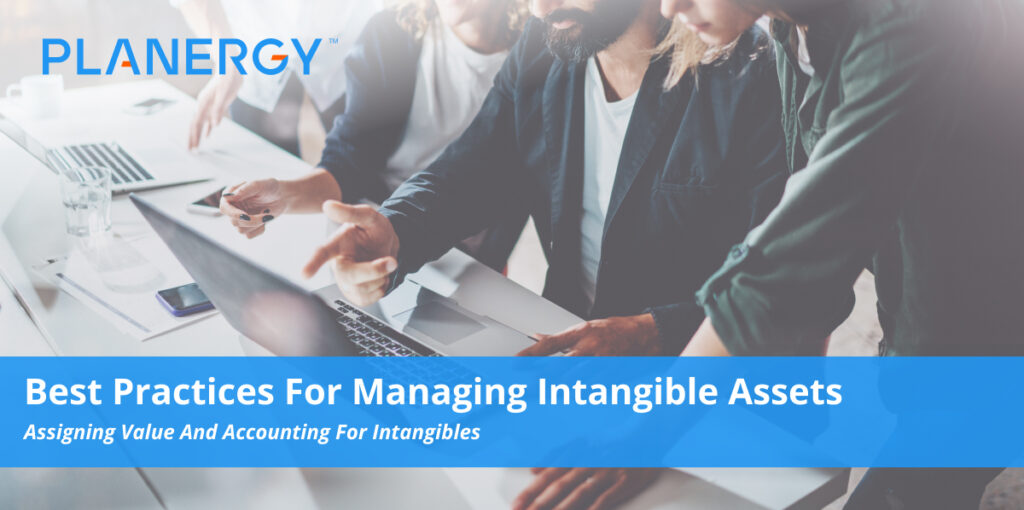The Cambridge Dictionary defines intangible as “impossible to touch, to describe exactly, or to give an exact value.” You already know that an asset is something of value that you own, such as a building or your equipment.
An intangible asset is also something of value that you own, but you cannot see nor touch an intangible asset, unlike your other physical assets.
For example, if you’re a software developer, you own the copyright on your software, which is likely one of the most important assets that you own. But you can’t touch that copyright. It’s intangible.
Are intangible assets important to your business?
When top executives were asked to name the most important value drivers for their business, the majority of their responses were intangible assets including the following metrics:
- Customer relationships
- Brand reputation
- Patented products or processes
- Customer satisfaction
- Quality of business processes
- Quality of people
But why are things such as brand reputation so valuable? It turns out that a strong brand and brand recognition is one of the largest influences for customers. It’s no secret that consumers prefer to do business with a company that they’re familiar with for a variety of reasons.
A strong brand can represent a guarantee of quality, stability, and durability, and in some cases, even boost social status. For example, a company that is known for its outstanding customer service will have more value than one where customers are treated poorly.
Because both brand recognition and unique patents also drive customers to a particular business, businesses can charge their customers premium pricing for the items they do sell. Even stock market performance can be impacted by intangible assets.
What are some common intangible assets?
Because intangible assets provide value to a business over an extended period of time, they are considered long-term assets, since they cannot be quickly converted to cash.
For example, when a well-known business is purchased, in most cases the most valuable asset being purchased is that company’s goodwill, which includes brand and name recognition. Other intangible assets include the following:
- Human capital management – Human capital includes the education, training, skills, loyalty, and intelligence that your current workforce holds. Difficult to quantify in monetary terms, human capital management or intellectual capital is considered an intangible asset.
- Trademarks – A trademark is a design or logo used exclusively by a particular business. Trademarking a logo prevents others from using it.
- Domain names – We’ve seen bidding wars in the past over domain names. A domain name can be expensed if inexpensive, but depending on how important the domain is to business operations, can also be considered an intangible asset.
- Noncompete agreements – Depending on the business, a non-compete agreement has value, as it prohibits future competition for a specified period of time.
- Customer lists – One of the most valuable items a business may own is its customer list.
- Customer relationships – Similar to the customer lists, customer relationships speak to the current relationship a business has with its customers, and how that value contributes to both current and future value.
- Copyrights – A copyright is part of the ownership of intellectual property. Copyrights are used to protect a variety of works including literary and musical works, as well as photography and illustrations. Copyrights are also used to protect musical recordings, film and television broadcasts, as well as non-literary work, such as software and web content. The life of copyright varies, depending on the type of property involved.
- Licensing agreements – A licensing agreement is considered an intangible asset since the holder of the license has been granted permission to use someone’s else work. For example, if you purchase an online accounting program, you’re usually given a limited license by the owner of the software to use its product.
- Service contracts – Certain types of contracts such as employment, advertising, or sales contracts can be considered intangible assets since they can add value to a business.
- Franchise agreements – Because a franchise agreement includes the use of the franchise name and all related services, a franchise agreement can be considered an intangible asset.
- Patents – A patent provides a company with exclusive rights, including the right to manufacture and/or sell a product. A patent can be acquired from another company, or an inventor can choose to patent their own invention.
- Trade secrets – Trade secrets are closely guarded by some of the top businesses. Whether it’s a highly coveted recipe or the latest technology, businesses take trade secrets seriously, since in many cases, they are the sole success driver.
- Research and development – For many companies, R & D is vital to remain successful. R & D is an intangible asset, impossible to assign a value to, but essential to continue doing business as usual.
Properly accounting for intangible assets can be tricky, since only assets with a stated value or acquired assets are recorded on your company balance sheet.
How to assign value to your intangible assets
Because of their nature, it can often be difficult to assess the value of intangible assets. Currently, three approaches are typically used by stakeholders when valuing intangible assets.
- Cost approach: The cost approach is based on the cost to recreate or replace the asset. Depending on the asset, you can use either development cost or replacement cost. The cost approach is typically used when there are no similar assets on the market that would allow for accurate value creation.
- Market approach: The market approach compares intangible assets against those held by similar businesses. For example, if your closest competitor recently sold a patent to another company, you can use the value of the patent that was sold to price your patent similarly. The market approach is usually used by businesses that frequently deal with patents and copyrights.
- Income approach: The income approach uses estimates of future cash flow or other monetary benefits that are expected to estimate intangible asset valuation properly.
Properly accounting for intangible assets can be tricky, since only assets with a stated value or acquired assets are recorded on your company balance sheet.
This is because current accounting standards do not recognize intangible assets unless or until a purchase takes place or a specific cost can be associated with the asset, though many businesses are preparing internal financial statements for their own use that can adequately track all intangible assets.
For example, any intangible asset such as a logo, (even a very recognizable one) would not appear on your balance sheet, since the logo was developed internally, making it impossible to assign a fair market value to it.
Only intangible assets that have a limited lifespan and an assigned fair market value can be recorded on your balance sheet.
This can include a patent that expires in ten years or copyright that reverts to the owner in five years.
Two categories of intangible assets
While we listed the types of intangible assets earlier, we can place each of those intangible assets into one of two categories; limited-life intangible assets or unlimited life intangible assets.
Limited-life intangible assets
Limited-life intangible assets are assets that have an expiration date. Limited life assets are always amortized over the period of their useful life. For example, Ted’s business purchased a patent from its competitor for $50,000 with an estimated life span of 15 years.
This same premise would apply to other limited-life intangible assets such as copyrights, licensing agreements, and patents.
Unlimited life intangible assets
Unlimited life intangible assets are assets that do not have an expiration date. Goodwill, including company reputation, are good examples of an unlimited life intangible asset because they do not expire.
Unlike a limited-life intangible asset, unlimited life intangible assets do not need to be amortized, since there is no way to accurately estimate the cost of the asset.
However, as part of their risk management strategy, companies should do an annual impairment test for any of their unlimited life intangible assets to examine any changing market conditions or any other issues or circumstances that may impact the value of the asset.
This know-how helps to ensure that your intangible assets are always valued properly.
All limited-life intangible assets should be amortized over their useful life. Amortization is similar to depreciation, but only uses one expense method, the straight-line method, which allows you to spread the cost of the intangible assets in equal amounts over its entire useful life.
For example, to amortize the above patent properly, you would divide the cost of the patent – $50,000 by 15 years, which is its useful life. That leaves you with an annual amortization of $3,333.33, or $277.78 per month.
To record monthly amortization, you will need to debit the amortization expense account and credit the intangible asset account.
Remember, only limited-life assets or those that were acquired from another business should appear as a monetary value on your balance sheet.
Recording intangible assets when purchasing another company
It’s much easier to value intangible assets when purchasing another company. For example, ABC Communications, a New York-based telecommunications company makes a deal to acquire its largest competitor, Advanced Communications for $5 million.
Currently, Advanced Communications is valued at $3.5 million, but because they have a stellar reputation in the industry, their true market value is much higher. Once ABC Communications acquires Advanced Communications, they can record the additional $1.5 million over the market value that they paid as an intangible asset on the company balance sheet.
Recording an intangible asset purchased from another company
The Cookie Palace has created a core group of loyal customers because of its unusual (and delicious) cookie recipes.
Currently, The Cookie Palace holds a patent on all of its cookie recipes. However, Jake’s Marketplace makes a deal with The Cookie Palace that allows them to recreate one of their most successful cookies.
To do so, Jake’s Marketplace purchases the use of a patent for seven years, which will allow them access to the recipe. The cost of purchasing the patent from The Cookie Palace is $250,000, which Jake’s Marketplace can record on their balance sheet as an intangible asset.
And because the patent expires in seven years, its cost should be amortized over its useful life.
Managing your intangible assets
Because you can see and touch tangible assets, such as furniture, equipment, machinery, and buildings, such assets are fairly easy to manage.
But you can quickly drift into unchartered territory when it comes to managing intangible assets properly, with the methodology somewhat murky at times.
Though these assets add a tremendous amount of value to your company, when it comes to managing intangible assets such as brand, company name or reputation, and customer relationships, it’s difficult, if not impossible, to place an accurate value on them.
And because in many cases they are not recorded on your balance sheet, it’s even more difficult to properly manage them internally, particularly during any decision-making process.
It’s also important to note that just because intangible assets don’t have an expiration date, it does not mean that they can’t be destroyed.
For example, improper use of social media tools can quickly devalue your company. Instead of responding professionally to a negative online review of your business, one of your employees responds with a series of insults.
The post quickly goes viral, with millions of social media users having access to the unprofessional post. The result is that your business reputation has now been damaged, and its value quickly diminished.
The purpose of intangible assets for your business
Both tangible and intangible assets add value to your business. Depending on your current business model, you may have a lot of intangible assets to manage, or only a few.
In either case, the management of intangible assets must be carried out properly, particularly since their value and sustainability underline how important they are to your business.
For example, a business with an easily recognizable name, an excellent reputation, and a large customer base will have more value than a business with expensive equipment, a building or warehouse, or furniture.
In addition, these Intangible resources such as goodwill can add additional value to your tangible assets as well.




